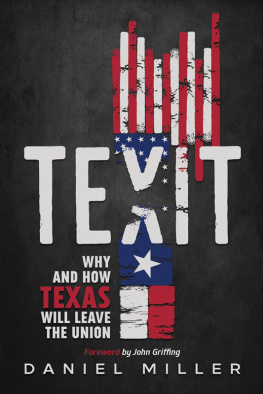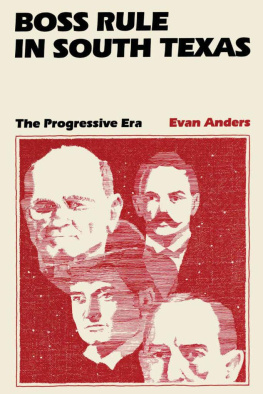STORM OVER TEXAS
STORM OVER TEXAS
THE ANNEXATION CONTROVERSY AND THE ROAD TO CIVIL WAR
JOEL H. SILBEY


Oxford University Press, Inc, publishes works that further
Oxford Universitys objective of excellence
in research, scholarship, and education
Oxford New York
Auckland Cape Town Dar es Salaam Hong Kong Karachi
Kuala Lumpur Madrid Melbourne Mexico City Nairobi
New Delhi Shanghai Taipei Toronto
With offices in
Argentina Austria Brazil Chile Czech Republic France Greece
Guatemala Hungary Italy Japan Poland Portugal Singapore
South Korea Switzerland Thailand Turkey Ukraine Vietnam
Copyright 2005 by Joel H Silbey
Published by Oxford University Press, Inc
198 Madison Avenue, New York, NY 10016
www.oup.com
Oxford IS a registered trademark of Oxford University Press
All rights reserved No part of this publication may be reproduced,
stored in a retrieval system, or transmitted, in any form or by any means,
electronic, mechanical, photocopying, recording, or otherwise,
without the prior permission of Oxford University Press
Library of Congress Cataloging inPublication Data
Silbey, Joel H
Storm over Texas the annexation controversy and the road to Civil War / Joel H Silbey
p cm (Pivotal moments in American history)
Includes bibliographical references and index
ISBN13 9780195139440
ISBN10 0195139445
I TexasAnnexation to the United States 2 TexasHistoryRepublic, 18361846
3 United StatesHistoryCivil War, 18611865Causes
4 United StatesPolitics and government18411845
5 United StatesPolitics and government18451861
I Title II Series
F390 S558 2005 976 4o4dc22 2005040636
1 3 5 7 9 8 6 4 2
Printed in the United States of America
on acidfree paper
Also by Joel H. Silbey
The Shrine of Party:
Congressional Voting Behavior, 18411852
A Respectable Minority:
The Democratic Party in the Civil War Era, 18601868
The Partisan Imperative:
The Dynamics of American Politics Before the Civil War
The American Political Nation, 18381893
Martin Van Buren and the Emergence of American Popular Politics

PIVOTAL MOMENTS IN AMERICAN HISTORY
Series Editors
David Hackett Fischer
James M. McPherson
James T. Patterson
Brown v. Board of Education:
A Civil Rights Milestone and Its Troubled Legacy
Maury Klein
Rainbows End: The Crash of 1929
James M. McPherson
Crossroads of Freedom: The Battle of Antietam
Glenn C. Altschuler
All Shook Up: How Rock n Roll Changed America
David Hackett Fischer
Washingtons Crossing
John Ferling
Adams vs. Jefferson: The Tumultuous Election of 1800
To Abigail V. Hogan
and her brother, Thomas P. S.
CONTENTS
PROLOGUE
The Joint Resolution For Annexing Texas to the United States Is Finally Passed
1 GOIN TO TEXAS
Texas in the American Imagination and Politics, 18211841
3 WE CANNOT CARRY VIRGINIA FOR YOU
Political Earthquake, 18431844
8 CONCLUSION
An Element of Overwhelming Ruin to the Republic
EDITORS NOTE
When Stephen Austin of Missouri settled the first of three hundred American families in the Mexican province of Texas in 182324 under a land grant from the Mexican government, no one foresaw the chain of events that would follow from this act and lead to the American Civil War four decades later. Yet that is precisely what happened, as Joel Silbey shows in this important new study of the Texas annexation controversy.
Achieving independence from Mexico in the revolution of 1836, AngloTexans petitioned for annexation to the United States. Expansionist Democrats, especially from the American South, eagerly supported acquisition of this huge new slave state, nearly half as large as the other fourteen slave states combined. Until 1844, however, Texas annexation was mainly a partisan rather than sectional issue, with Democrats from both North and South in favor and most Whigs in both sections against it. But in the presidential election campaign of that year, proslavery southerners added an ominous overlay of sectionalism to the issue. Secretary of State John C. Calhoun stated publicly that annexation was necessary to strengthen slavery, an institution essential to the peace, safety, and prosperity of the South. Calhouns predecessor in the State Department, the Virginian Abel Upshur, had also insisted that southerners must demand... the admission of Texas... as indispensable to their security. Both parties [in the South] may unite on that, for it is a Southern question, and not one of whiggism and democracy.
The election of Tennessees proannexation Democrat James K. Polk as president in 1844 settled the question. To balance Texas, Polk pledged to Northern Democrats the acquisition of Oregon territory all the way north to the latitude of 54 40. When Polk instead compromised with Britain on the 49th parallel but went to war with Mexico over the southern boundary of Texas, many northern Democrats felt they had been sold out. And when Pennsylvania Democrat David Wilmot introduced his famous Proviso prohibiting slavery in any territory acquired from Mexico, nearly all northern Democrats plus northern Whigs in the House voted for it while nearly all southern congressmen voted against it. As Silbey makes clear in one of the key themes of the book, this fateful wrenching of congressional voting patterns from partisan to sectional lines foreshadowed the crisis of secession and war fifteen years later.
That war was the consequence of cumulative events reaching back at least as far as the firebell in the night heard by Thomas Jefferson during the Missouri debates in 1820. But if there was a single pivotal moment in this series of events, it was surely the annexation of Texas in 1845. The Missouri Compromise had contained the genie of slavery expansion for a generation. Texas unstopped the bottle and let the genie out; all efforts during the next fifteen years to stuff him back in again failed. And the war came. This book tells the story of how that genie got out of the bottle.
James M. McPherson
As certain as truth and God exist, the admission of Texas into this Union will prove, sooner or later, an element of overwhelming ruin to the Republic.
Congressman Daniel Barnard of New York
on the floor of the House of Representatives,
January 1845

1844: Optimistic pro-annexationists believed that they were about to win their goal at last. LIBRARY OF CONGRESS.
PREFACE
THE MEXICAN PROVINCE OF TEXAS ATTRACTED much interest in the United States and drew many North American settlers to it in the early decades of the nineteenth century. That continuing interest and growing presence developed into a significant problem when the restive emigrants living in the province revolted against Mexican rule in the 1830s and successfully established an independent republic despite Mexicos bitter resistance to the separation. The new republics leaders then pushed hard to be annexed to the United States. At first they were held at arms length, by President Andrew Jackson and then by his successor, Martin Van Buren. But in the early 1840s a renewed and much stronger effort to bring Texas into the Union came to life and provoked a searing political controversy, which had profound longterm consequences for the nation.
Next page









